15 25 In Simplest Form
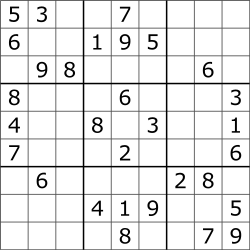
A typical Sudoku puzzle

The solution to the puzzle above
Sudoku (; Japanese: 数独, romanized: sūdoku , lit.'digit-single'; originally chosen Number Place)[1] is a logic-based,[2] [3] combinatorial[4] number-placement puzzle. In classic Sudoku, the objective is to make full a 9 × nine grid with digits so that each column, each row, and each of the ix three × three subgrids that compose the grid (also called "boxes", "blocks", or "regions") contain all of the digits from i to 9. The puzzle setter provides a partially completed grid, which for a well-posed puzzle has a single solution.
French newspapers featured variations of the Sudoku puzzles in the 19th century, and the puzzle has appeared since 1979 in puzzle books under the name Number Place.[5] However, the mod Sudoku just began to proceeds widespread popularity in 1986 when it was published by the Japanese puzzle company Nikoli nether the name Sudoku, meaning "unmarried number".[6] It get-go appeared in a U.S. paper, and and so The Times (London), in 2004, thanks to the efforts of Wayne Gould, who devised a computer plan to quickly produce unique puzzles.
History [edit]

From La France newspaper, July 6, 1895: The puzzle instructions read, "Use the numbers ane to 9 nine times each to complete the grid in such a way that the horizontal, vertical, and two main diagonal lines all add up to the same total."
Predecessors [edit]
Number puzzles appeared in newspapers in the late 19th century, when French puzzle setters began experimenting with removing numbers from magic squares. Le Siècle, a Paris daily, published a partially completed nine×nine magic square with three×three subsquares on November nineteen, 1892.[7] Information technology was non a Sudoku because information technology contained double-digit numbers and required arithmetic rather than logic to solve, but information technology shared key characteristics: each row, column and subsquare added upward to the same number.
On July six, 1895, Le Siècle 'south rival, La French republic, refined the puzzle then that information technology was virtually a mod Sudoku and named it carré magique diabolique ('diabolical magic square'). It simplified the ix×9 magic square puzzle so that each row, column, and cleaved diagonals independent only the numbers 1–9, but did non mark the subsquares. Although they were unmarked, each three×3 subsquare did indeed comprise the numbers 1–ix, and the additional constraint on the broken diagonals led to but one solution.[eight]
These weekly puzzles were a feature of French newspapers such every bit L'Écho de Paris for about a decade, but disappeared nearly the time of World War I.[ix]
Modern Sudoku [edit]
The modern Sudoku was nearly probable designed anonymously past Howard Garns, a 74-year-erstwhile retired builder and freelance puzzle constructor from Connersville, Indiana, and starting time published in 1979 by Dell Magazines as Number Place (the earliest known examples of modernistic Sudoku).[1] Garns'southward name was ever present on the listing of contributors in issues of Dell Pencil Puzzles and Discussion Games that included Number Place, and was always absent from issues that did not.[10] He died in 1989 before getting a chance to see his creation as a worldwide phenomenon.[x] Whether or non Garns was familiar with whatever of the French newspapers listed above is unclear.
The puzzle was introduced in Nihon by Maki Kaji ( 鍜治 真起 , Kaji Maki ) , president of the Nikoli puzzle visitor, in the newspaper Monthly Nikolist in Apr 1984[10] as Sūji wa dokushin ni kagiru ( 数字は独身に限る ), which can be translated as "the digits must exist unmarried", or as "the digits are limited to one occurrence" (In Japanese, dokushin means an "unmarried person"). The proper noun was later abbreviated to Sudoku (数独), taking only the first kanji of compound words to form a shorter version.[x] "Sudoku" is a registered trademark in Japan[11] and the puzzle is mostly referred to equally Number Place ( ナンバープレース , Nanbāpurēsu ) or, more informally, a shortening of the two words, Num(ber) Pla(ce) ( ナンプレ , Nanpure ). In 1986, Nikoli introduced two innovations: the number of givens was restricted to no more than than 32, and puzzles became "symmetrical" (meaning the givens were distributed in rotationally symmetric cells). It is now published in mainstream Japanese periodicals, such as the Asahi Shimbun.
Spread outside Japan [edit]
In 1997, Hong Kong judge Wayne Gould saw a partly completed puzzle in a Japanese bookshop. Over six years, he developed a computer program to produce unique puzzles quickly.[5] Knowing that British newspapers have a long history of publishing crosswords and other puzzles, he promoted Sudoku to The Times in Britain, which launched it on Nov 12, 2004 (calling it Su Doku). The first alphabetic character to The Times regarding Su Doku was published the post-obit mean solar day on Nov 13 from Ian Payn of Brentford, lament that the puzzle had caused him to miss his terminate on the tube.[12] Sudoku puzzles rapidly spread to other newspapers as a regular feature.[5] [thirteen]
The rapid rise of Sudoku in Uk from relative obscurity to a front-folio feature in national newspapers attracted commentary in the media and parody (such as when The Guardian 's G2 department advertised itself every bit the first newspaper supplement with a Sudoku grid on every page).[xiv] Recognizing the dissimilar psychological appeals of like shooting fish in a barrel and difficult puzzles, The Times introduced both, next, on June twenty, 2005. From July 2005, Aqueduct 4 included a daily Sudoku game in their teletext service. On August 2, the BBC's program guide Radio Times featured a weekly Super Sudoku with a 16×16 grid.
In the United States, the first newspaper to publish a Sudoku puzzle by Wayne Gould was The Conway Daily Sun (New Hampshire), in 2004.[15]

The world's start live TV Sudoku show, July ane, 2005, Sky One
The earth's first live TV Sudoku show, Sudoku Live, was a puzzle competition starting time circulate on July 1, 2005, on Heaven One. It was presented by Carol Vorderman. Ix teams of 9 players (with one celebrity in each squad) representing geographical regions competed to solve a puzzle. Each player had a hand-held device for inbound numbers corresponding to answers for four cells. Phil Kollin of Winchelsea, England, was the series k prize winner, taking dwelling house over £23,000 over a series of games. The audience at home was in a split interactive competition, which was won by Hannah Withey of Cheshire.
Afterward in 2005, the BBC launched SUDO-Q, a game evidence that combined Sudoku with general noesis. All the same, information technology used simply 4×iv and half dozen×6 puzzles. Four seasons were produced before the show concluded in 2007.
In 2006, a Sudoku website published songwriter Peter Levy's Sudoku tribute vocal,[16] but speedily had to have downwardly the MP3 file due to heavy traffic. British and Australian radio picked upwards the song, which is to feature[ when? ] in a British-made Sudoku documentary. The Japanese Diplomatic mission also nominated the song for an award, with Levy doing talks with Sony in Nihon to release the vocal as a single.[17]
Sudoku software is very popular on PCs, websites, and mobile phones. It comes with many distributions of Linux. Software has too been released on video game consoles, such as the Nintendo DS, PlayStation Portable, the Game Boy Advance, Xbox Alive Arcade, the Nook eastward-book reader, Kindle Fire tablet, several iPod models, and the iPhone. Many Nokia phones too had Sudoku. In fact, just two weeks after Apple Inc. debuted the online App Shop within its iTunes Store on July eleven, 2008, nearly 30 different Sudoku games were already in it, created by various software developers, specifically for the iPhone and iPod Affect. One of the nigh pop video games featuring Sudoku is Encephalon Age: Train Your Encephalon in Minutes a Mean solar day!. Critically and commercially well-received, it generated particular praise for its Sudoku implementation[18] [19] [20] and sold more than 8 million copies worldwide.[21] Due to its popularity, Nintendo made a second Brain Age game titled Encephalon Age2 , which has over 100 new Sudoku puzzles and other activities.
In June 2008, an Australian drugs-related jury trial costing over A$ i meg was aborted when information technology was discovered that 5 of the twelve jurors had been playing Sudoku instead of listening to bear witness.[22]
Variants [edit]

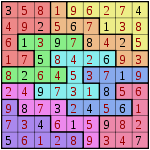
And its solution (ruddy numbers)
Variations of grid sizes or region shapes [edit]
Although the 9×9 grid with 3×3 regions is by far the about common, many other variations exist. Sample puzzles can be 4×4 grids with 2×2 regions; v×5 grids with pentomino regions accept been published under the name Logi-5; the World Puzzle Championship has featured a vi×6 filigree with 2×3 regions and a vii×7 grid with six heptomino regions and a disjoint region. Larger grids are likewise possible, or different irregular shapes (nether various names such as Suguru, Tectonic, Jigsaw Sudoku etc.). The Times offers a 12×12-grid "Dodeka Sudoku" with 12 regions of 4×iii squares. Dell Magazines regularly publishes xvi×16 "Number Place Challenger" puzzles (using the numbers 1–xvi or the letters A-P). Nikoli offers 25×25 "Sudoku the Giant" behemoths. A 100×100-filigree puzzle dubbed Sudoku-zilla was published in 2010.[23]
Mini Sudoku [edit]
Under the name "Mini Sudoku", a half-dozen×6 variant with 3×two regions appears in the American newspaper U.s. Today and elsewhere. The object is the same as that of standard Sudoku, but the puzzle but uses the numbers i through 6. A similar form, for younger solvers of puzzles, called "The Junior Sudoku", has appeared in some newspapers, such equally some editions of The Daily Mail.
Imposing additional constraints [edit]
Another mutual variant is to add together limits on the placement of numbers beyond the usual row, column, and box requirements. Frequently, the limit takes the grade of an extra "dimension"; the nigh mutual is to require the numbers in the chief diagonals of the grid to also be unique. The same "Number Place Challenger" puzzles are all of this variant, as are the Sudoku 10 puzzles in The Daily Post, which use 6×6 grids.
Killer Sudoku [edit]

A Killer Sudoku puzzle

And its solution
The Killer Sudoku variant combines elements of Sudoku and Kakuro.
Alphabetical Sudoku [edit]
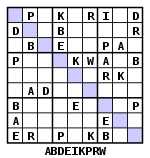
A Wordoku puzzle

And its solution (red characters)
Alphabetical variations have emerged, sometimes called Wordoku; no functional difference exists in the puzzle unless the messages spell something. Some variants, such equally in the Television Guide, include a discussion reading along a chief diagonal, row, or column one time solved; determining the word in advance can be viewed as a solving assist. A Wordoku might contain words other than the main give-and-take.
"Quadratum latinum" is a Sudoku variation with Roman numerals (I, 2, III, IV, ..., 9) proposed past Hebdomada aenigmatum, a monthly magazine of Latin puzzles and crosswords. Similar the Wordoku, information technology presents no functional difference from a normal Sudoku, but adds the visual difficulty of using Roman numerals.
Hyper Sudoku / Windoku [edit]
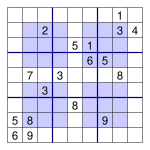
Hypersudoku puzzle
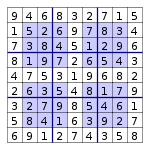
And its solution
Hyper Sudoku or Windoku uses the archetype 9×9 grid with three×three regions, but defines four additional interior 3×iii regions in which the numbers i–nine must appear exactly once. It was invented by Peter Ritmeester and outset published by him in Dutch Newspaper NRC Handelsblad in October 2005, and since Apr 2007 on a daily basis in The International New York Times (International Herald Tribune). The beginning time it was called Hyper Sudoku was in Volition Shortz's Favorite Sudoku Variations (February 2006). It is also known as Windoku because with the grid'south four interior regions shaded, it resembles a window with glazing bars.[24]
Twin Sudoku [edit]
In Twin Sudoku ii regular grids share a 3×3 box. This is i of many possible types of overlapping grids. The rules for each individual grid are the same as in normal Sudoku, but the digits in the overlapping section are shared by each one-half. In some compositions neither private grid can be solved alone – the complete solution is but possible afterwards each private grid has at least been partially solved.
Other variants [edit]
Puzzles synthetic from more than 2 grids are as well common. Five nine×9 grids that overlap at the corner regions in the shape of a quincunx is known in Nippon equally Gattai 5 (5 merged) Sudoku. In The Times, The Historic period, and The Sydney Morning Herald, this form of puzzle is known as Samurai Sudoku. The Baltimore Lord's day and the Toronto Star publish a puzzle of this variant (titled High Five) in their Sunday edition. Frequently, no givens are placed in the overlapping regions. Sequential grids, as opposed to overlapping, are as well published, with values in specific locations in grids needing to exist transferred to others.
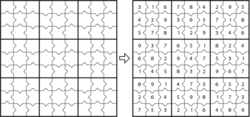
An instance of Greater Than Sudoku
A tabletop version of Sudoku tin can be played with a standard 81-menu Prepare deck (meet Ready game). A iii-dimensional Sudoku puzzle was published in The Daily Telegraph in May 2005. The Times also publishes a three-dimensional version under the name Tredoku. Also, a Sudoku version of the Rubik's Cube is named Sudoku Cube.
Many other variants have been developed.[25] [26] [27] Some are different shapes in the arrangement of overlapping ix×9 grids, such as butterfly, windmill, or bloom.[28] Others vary the logic for solving the grid. One of these is "Greater Than Sudoku". In this, a 3×3 grid of the Sudoku is given with 12 symbols of Greater Than (>) or Less Than (<) on the common line of the ii adjacent numbers.[ten] Another variant on the logic of solution is "Clueless Sudoku", in which nine 9×9 Sudoku grids are each placed in a 3×iii array. The center prison cell in each three×3 filigree of all nine puzzles is left blank and form a tenth Sudoku puzzle without any cell completed; hence, "clueless".[28] A new variant mixes Sudoku with the sliding tile puzzle in Sudoku Slide Extreme. In this variant all of the positions are filled in. Tiles are moved to the proper position to solve the puzzle. This variant contains ability-ups and a campaign mode.[ citation needed ] Examples and other variants tin can be institute in the Glossary of Sudoku.
Mathematics of Sudoku [edit]

This section refers to classic Sudoku, disregarding jigsaw, hyper, and other variants.
A completed Sudoku grid is a special type of Latin square with the boosted property of no repeated values in whatsoever of the 9 blocks (or boxes of three×3 cells). The human relationship between the two theories is known, after it was proven that a offset-order formula that does not mention blocks is valid for Sudoku if and only if it is valid for Latin squares.[29]
The general problem of solving Sudoku puzzles on n ii×due north 2 grids of n×due north blocks is known to exist NP-complete.[xxx] Many figurer algorithms, such as backtracking and dancing links can solve most 9×9 puzzles efficiently, but combinatorial explosion occurs as northward increases, creating limits to the backdrop of Sudokus that tin can be constructed, analyzed, and solved as n increases. A Sudoku puzzle tin be expressed as a graph coloring problem.[31] The aim is to construct a 9-coloring of a particular graph, given a partial ix-coloring.
The fewest clues possible for a proper Sudoku is 17 (proven January 2012, and confirmed September 2013).[32] [33] Over 49,000 Sudokus with 17 clues have been found, many by Japanese enthusiasts.[34] [35] Sudokus with 18 clues and rotational symmetry have been found, and there is at to the lowest degree ane Sudoku that has 18 clues, exhibits two-way diagonal symmetry and is automorphic. The maximum number of clues that can be provided while notwithstanding not rendering a unique solution is four short of a full grid (77); if two instances of 2 numbers each are missing from cells that occupy the corners of an orthogonal rectangle, and exactly 2 of these cells are within one region, the numbers tin can be assigned two means. Since this applies to Latin squares in full general, about variants of Sudoku have the same maximum.
The number of archetype 9×ix Sudoku solution grids is 6,670,903,752,021,072,936,960 (sequence A107739 in the OEIS), or around 6.67×1021 . This is roughly 1.ii×ten−half dozen times the number of nine×9 Latin squares.[36] Various other filigree sizes have also been enumerated—see the main article for details. The number of essentially different solutions, when symmetries such equally rotation, reflection, permutation, and relabelling are taken into business relationship, was shown to be just v,472,730,538[37] (sequence A109741 in the OEIS).
Unlike the number of consummate Sudoku grids, the number of minimal nine×ix Sudoku puzzles is not precisely known. (A minimal puzzle is one in which no clue tin be deleted without losing uniqueness of the solution.) However, statistical techniques combined with a puzzle generator[38] show that about (with 0.065% relative fault) 3.x × 1037 minimal puzzles and ii.55 × x25 nonessentially equivalent minimal puzzles exist.
Competitions [edit]

- The first World Sudoku Championship was held in Lucca, Italy, from March 10 to 11, 2006. The winner was Jana Tylová of the Czech Republic.[39] The competition included numerous variants.[forty]
- The second World Sudoku Championship was held in Prague, Czech republic, from March 28 to April ane, 2007.[41] The individual champion was Thomas Snyder of the Usa. The team champion was Japan.[42]
- The third World Sudoku Championship was held in Goa, India, from Apr fourteen to 16, 2008. Thomas Snyder repeated every bit the individual overall champion, and also won the offset ever Archetype Trophy (a subset of the competition counting merely classic Sudoku). The Czech republic won the team contest.[43]
- The quaternary World Sudoku Championship was held in Žilina, Slovakia, from April 24 to 27, 2009. Later by champion Thomas Snyder of the US won the general qualification, January Mrozowski of Poland emerged from a 36-competitor playoff to become the new Earth Sudoku Champion. Host nation Slovakia emerged equally the top squad in a split up competition of 3-membered squads.[44]
- The fifth Earth Sudoku Title was held in Philadelphia, Pennsylvania, from April 29 to May two, 2010. Jan Mrozowski of Poland successfully dedicated his world championship in the individual contest, while Germany won a separate team event. The puzzles were written by Thomas Snyder and Wei-Hwa Huang, both past U.Due south. Sudoku champions.[45]
- The twelfth World Sudoku Title (WSC) was held in Bangalore, India, from Oct 15 to 22, 2017. Kota Morinishi of Nippon won the Individual WSC and China won the team consequence.[46]
- The 13th Globe Sudoku Championship took identify in the Czech Commonwealth.[47]
- In the United States, The Philadelphia Inquirer Sudoku National Championship has been held 3 times, each time offering a $10,000 prize to the advanced sectionalization winner and a spot on the U.S. National Sudoku Team traveling to the world championships. The winners of the event were Thomas Snyder (2007),[48] Wei-Hwa Huang (2008), and Tammy McLeod (2009).[49] In the 2009 event, the 3rd-place finalist in the advanced division, Eugene Varshavsky, performed quite poorly onstage after setting a very fast qualifying time on paper, which caught the attention of organizers and competitors including by champion Thomas Snyder, who requested organizers reconsider his results due to a suspicion of cheating.[50] Following an investigation and a retest of Varshavsky, the organizers butterfingers him and awarded the 3rd-place to Chris Narrikkattu.[51]
Meet also [edit]
- 36 Cube
- Blendoku
- Constraint satisfaction problem
- Swell the Cryptic
- Futoshiki
- Glossary of Sudoku
- Hashiwokakero
- Hidato
- KenKen
- Listing of Nikoli puzzle types
- Logic puzzle
- Nonogram
- Str8ts
- Sudoku solving algorithms
References [edit]
- ^ a b Grossman, Lev (March 11, 2013). "The Answer Men". Fourth dimension. New York. Archived from the original on March 1, 2013. Retrieved March 4, 2013. (registration required)
- ^ Arnoldy, Ben. "Sudoku Strategies". The Christian Science Monitor.
- ^ Schaschek, Sarah (March 22, 2006). "Sudoku champ's surprise victory". The Prague Post. Archived from the original on Baronial 13, 2006. Retrieved February 18, 2009.
- ^ Lawler, Eastward. L. (1985). The Traveling Salesman Problem: A Guided Tour of Combinatorial Optimization . W Sussex: John Wiley & Sons. ISBN0-471-90413-9.
- ^ a b c Smith, David (May xv, 2005). "So you thought Sudoku came from the State of the Rise Sun ..." The Observer . Retrieved June 13, 2008.
The puzzle gripping the nation really began at a modest New York magazine
- ^ Hayes, Brian (2006). "Unwed Numbers". American Scientist. 94 (1): 12–fifteen. doi:10.1511/2006.57.3475.
- ^ Boyer, Christian (May 2006). "Supplément de l'article "Les ancêtres français du sudoku"" (PDF). Cascade la Science (in French): one–half dozen. Archived from the original (PDF) on Dec 10, 2006. Retrieved August 3, 2009.
- ^ Boyer, Christian (2007). "Sudoku's French ancestors" (in French). (personal webpage). Archived from the original on Oct ten, 2007. Retrieved August iii, 2009.
- ^ Malvern, Jack (June three, 2006). "Les fiendish French vanquish u.s.a. to Su Doku". Times Online. London. Retrieved September 16, 2006.
- ^ a b c d e Pegg, Ed Jr. (September 15, 2005). "Ed Pegg Jr.'s Math Games: Sudoku Variations". MAA Online. The Mathematical Association of America. Retrieved October 3, 2006.
- ^ "Reg. No. 5056856". Japanese Trademark 5056856. Nippon Platform for Trademark Information. Retrieved October 3, 2018.
- ^ "Messages". Timesonline.co.uk. November 14, 2004. (subscription required)
- ^ Devlin, Keith (January 28–29, 2012). "The Numbers Game (book review of Taking Sudoku Seriously by Jason Rosenhouse et al.)". The Wall Street Journal. Weekend Edition. p. C5.
- ^ "G2, home of the discerning Sudoku addict". The Guardian. London. May thirteen, 2005. Retrieved September sixteen, 2006.
- ^ "Correction fastened to "Inside Japan's Puzzle Palace"". The New York Times. March 21, 2007.
- ^ "Sudoku the song, by Peter Levy". Sudoku.org.uk. August 17, 2006. Retrieved October five, 2008.
- ^ "Striking Vocal Has the Numbers". The Herald Sun. August 17, 2006. Retrieved October 5, 2008.
- ^ "Brain Age: Train Your Encephalon in Minutes a Day!". Gamerankings.com.
- ^ "Brain Historic period: ... Review". Gamespot.com.
- ^ "Brain Age: ... Review" Archived Baronial 11, 2012, at the Wayback Motorcar. IGN.com.
- ^ Thorsen, Tor (October 26, 2006). "Nintendo posts $456.six million profit". GameSpot . Retrieved March 29, 2013.
- ^ Knox, Malcolm (June 11, 2008). "The game'southward up: jurors playing Sudoku abort trial". The Sydney Morning Herald . Retrieved June 11, 2008.
- ^ Eisenhauer, William (2010). Sudoku-zilla. CreateSpace. p. 220. ISBN978-one-4515-1049-2.
- ^ "What is Hyper Sudoku?". sudoku-space.com . Retrieved Baronial 27, 2017.
- ^ *Snyder, Thomas; Huang, Wei-Hwa (2009). Mutant Sudoku. Puzzlewright Press. ISBN978-1-402765025.
- ^ Conceptis, Puzzles (2013). Amazing Sudoku Variants. Puzzlewright. ISBN978-1454906520.
- ^ Murali, A V (2014). A Collection of Fascinating Games and Puzzles. CreateSpace Independent Publishing Platform. ISBN978-1500216429.
- ^ a b "Zahlenraetsel". janko.at.
- ^ Berthier, Denis (2007). The Hidden Logic of Sudoku. LULU PR. p. 76 N. ISBN978-ane-84753-472-9.
p. 76.: "whatever block-free resolution rule is already valid in the theory of Latin Squares extended to candidates". Restated more explicitly in the second edition, p. 86, equally: "a block-free formula is valid for Sudoku if and only if it is valid for Latin squares"
- ^ "NP complete – Sudoku" (PDF). Imai.is.su-tokyo.air conditioning.jp. Archived from the original (PDF) on March iii, 2020. Retrieved Oct xx, 2013.
- ^ Lewis, R. A Guide to Graph Colouring: Algorithms and Applications. Springer International Publishers, 2015.
- ^ G. McGuire, B. Tugemann, G. Civario. "In that location is no 16-Clue Sudoku: Solving the Sudoku Minimum Number of Clues Problem". Arxiv.org.
- ^ H.H. Lin, I-C. Wu. "No 16-clue puzzles exist. BOINC was used to solve information technology afterward 2 years and 8 months or so.", September, 2013.
- ^ Royle, Gordon. "Minimum Sudoku". Archived from the original on November 26, 2006. Retrieved February 28, 2012.
- ^ プログラミングパズルに関心のある人は雑談しましょう. プログラミングパズル雑談コーナー [Programming Puzzle Idle Talk Corner] (in Japanese). Archived from the original on Oct 12, 2016. Retrieved September 16, 2006.
- ^ Jarvis, Frazer (July 31, 2006). "Sudoku enumeration problems". Frazer Jarvis's home page . Retrieved September sixteen, 2006. Detailed calculation of this figure.
- ^ Jarvis, Frazer; Russell, Ed (September 7, 2005). "In that location are 5472730538 essentially different Sudoku grids ... and the Sudoku symmetry group". Frazer Jarvis's domicile page . Retrieved September sixteen, 2006.
- ^ Berthier, Denis (December four, 2009). "Unbiased Statistics of a CSP – A Controlled-Bias Generator". In Elleithy, Khaled (ed.). Innovations in Calculating Sciences and Software Engineering. pp. 165–70. Bibcode:2010iics.volume.....Due south. Retrieved December 4, 2009.
- ^ "Sudoku title for Czech auditor". BBC News. March 11, 2006. Retrieved September xi, 2006.
- ^ "Globe Sudoku Championship 2006 Instructions Booklet" (PDF). BBC News . Retrieved May 24, 2010.
- ^ "Report on the 8th General Assembly of the World Puzzle Federation". Globe Puzzle Federation. October 30, 2006. Archived from the original on September 26, 2007. Retrieved November xv, 2006.
- ^ "Thomas Snyder wins World Sudoku Title". US Puzzle Team. March 31, 2007. Retrieved April 18, 2008.
- ^ Harvey, Michael (April 17, 2008). "It'south a puzzle but dominicus, ocean and beer can't compete with Sudoku for British team". TimesOnline. London. Retrieved April 18, 2008.
- ^ Malvern, Jack (April 27, 2009). "Su Doku battle goes a little off the wall". TimesOnline. London. Retrieved April 27, 2009.
- ^ "Pole, 23, repeats equally Sudoku world champ". PhillyInquirer. May 2, 2009. Archived from the original on May 5, 2010. Retrieved August 3, 2013.
- ^ "WSPC 2017 - Logic Masters Bharat". wspc2017.logicmastersindia.com.
- ^ "World Sudoku Championships | WPF". orldpuzzle.org.
- ^ "Thomas Snyder, Earth Sudoku champion". The Philadelphia Inquirer. October 21, 2007. Retrieved Oct 21, 2007.
- ^ Shapiro, Howard (October 25, 2009). "Going for 2d, she wins 1st". The Philadelphia Inquirer. Archived from the original on November 2, 2009. Retrieved August 3, 2013.
- ^ Timpane, John (October 27, 2009). "Possible cheating probed at Sudoku National Championship". The Philadelphia Inquirer. Archived from the original on November 1, 2009. Retrieved August 3, 2013.
- ^ "third-place winner disqualified in Sudoku scandal". The Philadelphia Inquirer. Nov 24, 2009. Archived from the original on November 27, 2009. Retrieved August 3, 2013.
Further reading [edit]
- Delahaye, Jean-Paul, "The Science Backside Sudoku", Scientific American, June 2006.
- Provan, J. Scott, "Sudoku: Strategy Versus Structure", American Mathematical Monthly, October 2009. Published also as a University of North Carolina technical written report UNC/STOR/08/04, 2008.
External links [edit]
![]()
Wikimedia Commons has media related to Sudoku.
- 'Sudoku Variations' from Fun With Puzzles
- Sudoku at Curlie – An active listing of Sudoku links
- 'Father of Sudoku' puzzles next move (BBC)
15 25 In Simplest Form,
Source: https://en.wikipedia.org/wiki/Sudoku
Posted by: kosstrumsess.blogspot.com


0 Response to "15 25 In Simplest Form"
Post a Comment